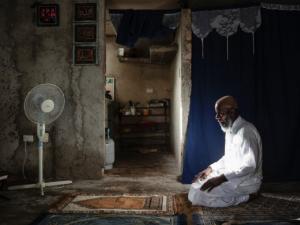Short Description
“When I learned there was Islam and a Muslim community in Cuba, I really liked it because I never heard of it,” CNN reported citing Photographer Joan Alvado.
“When I learned there was Islam and a Muslim community in Cuba, I really liked it because I never heard of it,” CNN reported citing Photographer Joan Alvado.
“It was breaking all the preconceived ideas that we have about Cuban society.”
Most of the images we see out of Cuba are similar classic cars here, vibrantly colored buildings there. But Alvado shows us something different. His photo series, “Cuban Muslims,” focuses on the lives of those who have converted to Islam. An estimated 85 percent of Cubans are Catholic and only 0.1 percent of the population are Muslims, according to a 2009 study by the Pew Research Center (PDF).
He says the reasons for conversion vary. While some people view Islam as “a little bit more true or pure religion than others,” there are those who turn to Islam for more personal and specific reasons. He provided the example of how Islam might be positive for those who have problems with alcohol, as Islam is a way for them to avoid alcohol. The Qur’an forbids the consumption of intoxicants and alcoholic beverages.
There are challenges, though, that come with practicing Islam in a country where it’s such a drastic minority. One of the main ones is finding a place to worship.
“The communities are being organized in very, very small groups, and someone in each group will offer their home on Fridays (to pray) or something like that,” he said. Alvado says Cuban Muslims are constantly learning about their new religion and evolving together.
“Everyone is doing a little bit of their own interpretation on how to read (Islamic) rules and be with them, more or less, and that’s interesting,” he said.
“I have learned more things about Islam and Islamic beliefs and their ideas in Havana than working in Turkey,” the Spanish photographer said. Cuba is a spiritual and passionate city, he said, especially when it comes to religion. In the beginning, he wasn’t sure how people would react to him wanting to photograph their lives.
As of 2012, most of the nearly 10,000 Cuban Muslims were converts to the religion, according to Wikipedia. At a certain point there were many Muslim students entering the nation of Cuba interested in studying at Cuba’s prestigious schools. The amount of students was approximately 1500-2000. Among that group were students of Pakistani origin, among others. It is known that the dominant population that went to study at Cuba was the Pakistani students who were about 936 in strength.
In 2001, Sheikh Muhammad bin Nassir Al-Aboudy, the Assistant Secretary-General of the Muslim World League (MWL) travelled to Cuba to obtain permission from the Cuban authorities to establish an Islamic organization that would support Cuba’s Muslim community. Among the other aims of the proposed organization would be constructing mosques and the dissemination of Islamic culture among Muslims, Wikipedia reported.
As of July 2015 the Turkish Religious Affairs Foundation had opened the first prayer room for Cuban Muslims and the first mosque in Cuba was under construction with Turkish funding. Cuban Muslims learned Islam through embassies of Middle Eastern countries as well as through students coming to study in Cuba from Muslim countries. Islam started to spread among Cubans in the 1970s and ’80s. Printed and audio-visual Islamic resources are now almost nonexistent in Cuba. Spanish translation of the Qur’an and other major Islamic books are not available in the country. The Muslim community of Cuba even lacks educated religious cadres
source:
http://www.islamicnewsdaily.com/nations/americas/la/islam-starts-flourishing-cuba-report/






![نصيحتي لك: اذكر الله [1 / 12] نصيحتي لك: اذكر الله [1 / 12]](https://300035.dotdothktrade.tech/images/upload/content_thumbs/1913613138ragheb-al-serjany-videos.jpg)


Comments
Send your comment